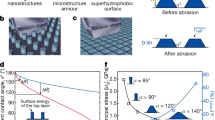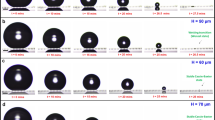Abstract
We consider theoretically the Cassie-Baxter and Wenzel states describing the wetting contact angles for rough substrates. More precisely, we consider different types of periodic geometries such as square protrusions and disks in 2D, grooves and nanoparticles in 3D and derive explicitly the contact angle formulas. We also show how to introduce the concept of surface disorder within the problem and, inspired by biomimetism, study its effect on superhydrophobicity. Our results, quite generally, prove that introducing disorder, at fixed given roughness, will lower the contact angle: a disordered substrate will have a lower contact angle than a corresponding periodic substrate. We also show that there are some choices of disorder for which the loss of superhydrophobicity can be made small, making superhydrophobicity robust.
Graphical abstract

Similar content being viewed by others
References
P. Roach, N.J. Shirtcliffe, M.I. Newton, Soft Matter 4, 224 (2008).
X. Zhang, F. Shi, J. Niu, Y. Jiang, Z. Wang, Journal of Materials Chemistry 18, 621 (2008).
J. Genzer, K. Efimenko, Biofouling 22, 339 (2006).
D. Quéré, Annu. Rev. Mater. Res. 38, 71 (2008).
C. Yang, U. Tartaglino, B. Persson, Phys. Rev. Lett. 97, 116103 (2006).
M. Sbragaglia, A.M. Peters, C. Pirat, B.M. Borkent, R.G.H. Lammertink, M. Wessling, D. Lohse, Phys. Rev. Lett. 99, 156001 (2007).
B. Bhushan, Phil. Trans. R. Soc. A 367, 1445 (2009).
R. Rioboo, M. Voué, A. Vaillant, D. Seveno, J. Conti, A.I. Bondar, D.A. Ivanov, J. De Coninck, Langmuir 24, 9508 (2008).
S. Desbief, B. Grignard, C. Detrembleur, R. Rioboo, A. Vaillant, D. Seveno, M. Voué, J. De Coninck, A.M. Jonas, C. Jérome, P. Damman, R. Lazzaroni, Langmuir 26, 2057 (2010).
B. Grignard, A. Vaillant, J. De Coninck, M. Piens, A.M. Jonas, C. Detrembleur, C. Jérome, Langmuir 27, 335 (2011).
J. De Coninck, F. Dunlop, T. Huillet, J. Stat. Mech., P06013 (2011).
P. Collet, J. De Coninck, F. Dunlop, A. Regnard, Phys. Rev. Lett. 79, 3704 (1997).
P. Collet, J. De Coninck, K. Drouiche, F. Dunlop, Colloid Polym. Sci. 291, 291 (2013).
R. Rioboo, B. Delattre, D. Duvivier, A. Vaillant, J. De Coninck, Adv. Colloid Interface Sci. 175, 1 (2012).
W. Barthlott, C. Neinhuis, Planta 202, 1 (1997).
P.S. Tsai, Y.M. Yang, Y.L. Lee, Nanotechnology 18, 465604 (2007).
Author information
Authors and Affiliations
Corresponding author
Rights and permissions
About this article
Cite this article
De Coninck, J., Dunlop, F. & Huillet, T. Is superhydrophobicity robust with respect to disorder?. Eur. Phys. J. E 36, 104 (2013). https://doi.org/10.1140/epje/i2013-13104-2
Received:
Revised:
Accepted:
Published:
DOI: https://doi.org/10.1140/epje/i2013-13104-2




